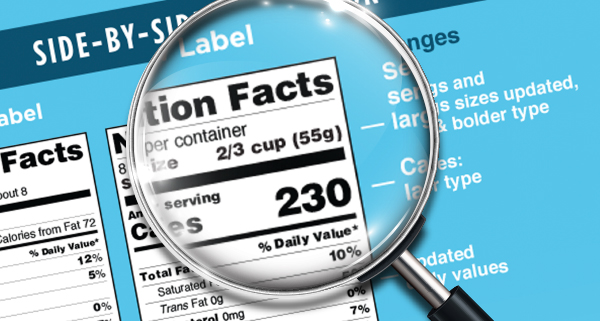
Food Label Changes: What You Don’t Know Or Haven’t Thought About
2019/07/23 1:41 pm
Effective Dates:
- January 1, 2020: Companies OVER $10 million in annual food sales
- January 1, 2021: Companies UNDER $10 million in annual food sales
- July 1, 2021 – Manufacturers of single-ingredient sugar products such as honey, syrup and certain cranberry-based foods
A Single Serving Size will be redefined as a serving that can reasonably be consumed by a single person in one sitting.
For example:
- A serving size of ice cream will increase from a half cup to 2/3 of a cup.
- Beverage cans and bottles will be counted as one serving because people tend to drink an entire beverage at one time, regardless of size.
For more specifics, visit the FDA’s RACC (Reference Amounts Customarily Consumed: CFR 21 §101.12) which is updated regularly.
Dual-Column Data: Per Serving AND Per Package
Products that are larger than a single serving but could be consumed in a single sitting or multiple sittings must provide a dual column label to indicate the number of calories and nutrients on both a Per Serving AND Per Package or Per Unit basis.
IMPORTANT NOTE: The addition of the dual column format may require significant changes to the existing packaging design.
Other Important Changes:
- Serving Size: Must be in large, bold, easy-to-read print
- Calories Per Serving: Will reflect new serving sizes and be in large, bold, easy-to-read print
- Calories From Fat: This section is being removed. However, Total Fat, Saturated Fat and Trans Fat will remain on the label.
- Added Sugars: Will be listed by weight and percent of daily value
- Required Nutrient Changes: Must list the actual amount, in addition to percent Daily Value, of vitamin D, calcium, iron and potassium.
- Newly Required – Vitamin D and Potassium
- No Longer Required – Vitamins A and C
Exemptions
Some manufacturers may be exempt from the labeling requirements, including low-volume producers with fewer than 100 full-time equivalent employees and moving less than 100,000 units per year.
Bottom Line
All of the changes implemented by the FDA will require changes to the nutritional label itself.
When the dual-column format must be used for Per Serving and Per Package food items, the entire package may need to be redesigned. These changes could take time to implement as a new design needs to be created and new plates made. If you haven’t started this process already, submit a contact form and we’ll get you on the path to compliance today.
Reference Information:
FDA Regulation on Food Labeling CFR Title 21.101
RECENT POSTS
- Quality Printing: Your Brand’s Most Important Advocate
- EPR PACKAGING LEGISLATION: IF YOU ARE A BRAND OWNER, YOU WILL BE AFFECTED
- WEBINAR | EPR LEGISLATION: WHAT BRAND OWNERS AND MANUFACTURERS NEED TO KNOW
- GREAT AMERICAN PACKAGING WELCOMES MARK MCANLIS AS VP OF SALES
- 5 Packaging Tips that Will Increase Your ROI

